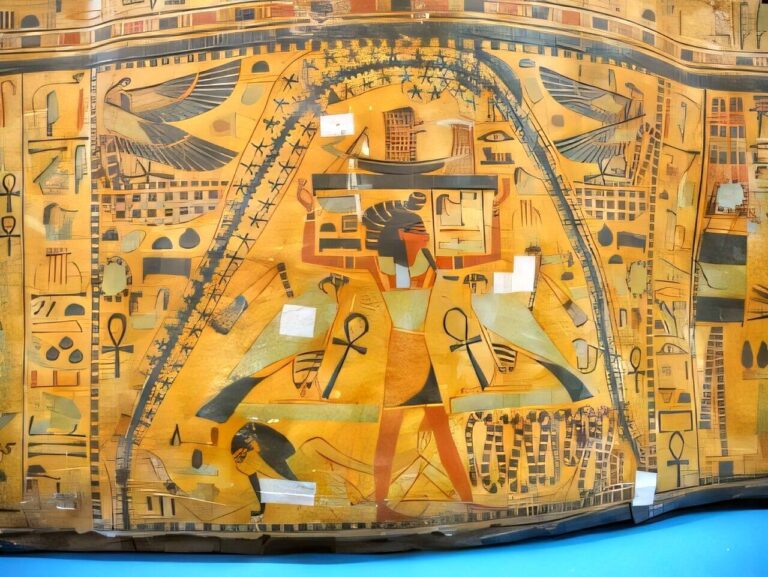
Scientists discover the oldest representations of the Milky Way in Ancient Egyptian art.
How did your country report this? Share your view in the comments.
Diverging Reports Breakdown
Scientists discover the oldest representations of the Milky Way in Ancient Egyptian art.
Researchers have uncovered what may be the oldest visual representations of the Milky Way in ancient Egyptian artifacts. The discovery centers on depictions of Nut, the Egyptian sky goddess, who appears on coffins dating back nearly 5,000 years. Dr. Or Graur, an astrophysics associate professor at the University of Portsmouth, has identified distinctive wavy black curves on ancient coffins that bear striking similarities to our galaxy’s appearance in the night sky. This discovery provides new insight into how ancient Egyptians perceived and represented celestial phenomena, similar to how NASA’s exploration of Mars has reshaped our understanding of the Red Planet’s history. The findings are published in the Astronomical Journal (20) and provide a fascinating bridge between ancient mythology and modern astrophysics. The research suggests ancient Egyptians recognized the distinct appearance of the. Milky Way and incorporated it into their artistic and religious expressions of astronomical expressions. This demonstrates that sophisticated observational skills predate modern scientific instruments by millennia, Dr. Graur says. As our understanding. of ancient astronomical knowledge expands, researchers continue to uncover surprising connections between ancient cultures and the cosmos.
Ancient coffins reveal cosmic connections in Egyptian mythology
The discovery centers on depictions of Nut, the Egyptian sky goddess, who appears on coffins dating back nearly 5,000 years. Dr. Graur examined 125 representations of Nut found on 555 ancient Egyptian coffins, focusing particularly on unusual artistic elements that might connect to celestial observations.
On the outer coffin of Nesitaudjatakhet, a singer of Amon-Ra who lived approximately 3,000 years ago, Nut’s body features a distinctive undulating black curve. This curve stretches from her feet to her fingertips, with stars painted in roughly equal numbers above and below it. The pattern bears remarkable similarity to the Great Rift – the dark dust band that bisects the Milky Way’s diffuse glow.
“The wavy curve likely represents the Milky Way and may correspond to the Great Rift,” explained Dr. Graur. “Comparing this representation to a photograph of the Milky Way shows a striking resemblance.” This discovery provides new insight into how ancient Egyptians perceived and represented celestial phenomena, similar to how NASA’s exploration of Mars has reshaped our understanding of the Red Planet’s history.
Stellar patterns and mythological significance
In traditional Egyptian cosmology, Nut appears as a star-covered, arched woman who protects Earth from the floods of the void. She plays a central role in the solar cycle, absorbing the sun at dusk and giving it new life at dawn. Her curved posture symbolizes her identification with the sky and her protective function over Earth.
Similar wavy curves appear in four tombs in the Valley of the Kings. In Ramses VI’s tomb, the burial chamber ceiling features two arched figures of Nut arranged back-to-back, separated by thick golden wavy curves. These architectural elements further support the theory that ancient Egyptians incorporated observations of the Milky Way into their religious artwork.
The rarity of these particular wavy patterns strengthens Dr. Graur’s conclusion that while Nut and the Milky Way are connected, they aren’t identical. “Nut isn’t a representation of the Milky Way,” he stated. “Rather, the Milky Way, like the sun and stars, is one of many celestial phenomena that can adorn Nut’s body in her function as the sky.” This complex relationship between mythology and astronomy reminds us how ancient cultures interpreted mysterious cosmic phenomena through cultural frameworks.
Evolving understanding of Egypt’s astronomical knowledge
Dr. Graur’s research builds on his previous work published in April 2024, which analyzed ancient texts including the Pyramid Texts, Coffin Texts, and the Book of Nut. By comparing these sources with sophisticated simulations of the Egyptian night sky, he suggested that the Milky Way might have illuminated Nut’s role as the sky in Egyptian mythology.
He proposed that in winter, the Milky Way highlighted Nut’s extended arms, while in summer, it traced her spine across the celestial vault. His understanding has evolved since that initial publication. “The texts alone suggested one way of understanding the connection between Nut and the Milky Way,” Dr. Graur noted. “Analyzing her visual representations on coffins and funerary paintings added a new dimension that literally painted a different picture.”
This research is part of Dr. Graur’s broader project to catalog and study the multicultural mythology of the Milky Way. Modern astronomical research continues this ancient fascination with our galaxy, as scientists develop new telescopes that could reveal undiscovered planets in our solar system.
Scientific implications for ancient astronomical knowledge
The discovery provides valuable insights into the astronomical knowledge of ancient Egyptians and how they integrated celestial observations into their religious practices. Much like modern scientists studying lunar formations, ancient Egyptian astronomers made careful observations of the night sky.
The research suggests that ancient Egyptians recognized the distinct appearance of the Milky Way and incorporated it into their artistic and religious expressions. This level of astronomical awareness demonstrates sophisticated observational skills that predate modern scientific instruments by millennia.
As our understanding of ancient astronomical knowledge expands, researchers continue to uncover surprising connections between ancient cultures and the cosmos. These discoveries highlight humanity’s enduring fascination with the night sky, from ancient Egyptian coffins to unexpected scientific discoveries in modern times.
The findings are published in the Journal of Astronomical History and Heritage (2025), providing a fascinating bridge between ancient mythology and modern astrophysics. As environmental changes continue to impact our planet—from massive icebergs threatening island ecosystems to mechanisms accelerating species collapse—understanding how ancient civilizations perceived their relationship with the cosmos offers valuable perspective on humanity’s place in the universe.
